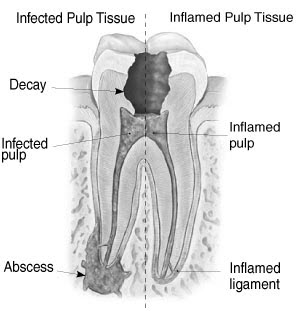Do I really need a root canal?!
That's what Dr. Conner needs to find out.
She will examine not only the tooth that appears to be causing the problem, she will examine surrounding teeth as well. Among other things, she wants to rule out "referred" pain. She uses several methods and specialized instruments. She needs to be able to reproduce your symptoms so please don't take any pain medications or anti-inflammatories the day of your exam (Tylenol, Ibuprofen, Advil, aspirin, etc.). Do take your regular, prescribed medications.
If I need a root canal, what should I expect?

It should just feel like a long, boring filling. Dr. Conner will use several different kinds of anesthesia to make sure your tooth is good and numb. The rule here is if it hurts, she stops. Like other endondontic specialists in the area, Dr. Conner uses a microscope and rubber dam for the procedure. The microscope lets her see into your canals (this is also useful for seeing cracks inside your tooth to determine if your tooth is restorable). The rubber dam ensures bacteria in your mouth do not contaminate the tooth once she disinfects it. That does mean your mouth will be covered so you will need to be able to breathe through your nose during the procedure.

We use digital radiographs (x-rays) that minimize your exposure to radiation. The amount of exposure is similar to your television.
If you are feeling especially stressed or anxious, please let Dr. Conner know. She will discuss the possibility of prescribing an anxiolytic for you. There's just no need to be stressed - life is too short!


We have radio/CD players in our operatories so you can listen to the music you like best. If you want to listen to your own mix, just bring your favorite music player.
If you have a latex allergy, please let Dr. Conner know and we will make sure all of our staff members wear latex-free gloves and use latex-free materials.
What is a root canal treatment anyway?!

Basically, the canals in your tooth have nerves and blood vessels in them (pulp tissue). When they get infected, you need to treat the infection. If you are having a lot of pain with the tooth, either the nerve is dying or there is a lot of infection. Sometimes they just die quietly and you don't know anything is wrong (eventually, infection takes over and that may cause pain). In either case, the nerves and blood vessels are removed, the canals are cleaned and disinfected to kill any bacteria, and a permanent root filling is placed inside the roots of your tooth (you still need a permanent restoration on the part of your tooth you see).
The American Association of Endodontists has great resources available. We've copied some of their basic information onto our About Endodontics pages (with permission, of course). If you want to know more, visit http://www.aae.org. We also have a video explaining a root canal procedure.
What about after it's done?
How you feel when you leave depends on how you felt when you came in. Most patients have immediate relief and feel great afterwards. If your tooth was really hurting before the root canal, it can take a few days for things to calm down. There is typically some soreness from the anesthesia and the rubber dam clamp. If appropriate, Dr. Conner will suggest taking Ibuprofen or Tylenol for a day or so to minimize the discomfort.
If your tooth is cracked or fragile, Dr. Conner will tell you whether or not it is safe to eat on that tooth.
Once the root canal treatment is completed, Dr. Conner will refer you back to your general dentist for a permanent restoration of your tooth.
Is that all there is?
Actually, while the most common procedure is a root canal treatment, endodontists do lot more. Here are other common procedures:
Retreatment - if an endodontically treated tooth becomes re-infected, it has to be retreated. This can happen for several reasons and Dr. Conner will be happy to discuss your particular case with you.
Saving knocked out teeth - Dr. Conner can work with your dentist to save teeth that have been knocked loose or knocked out completely. The International Association of Dental Traumatology has information about dental injuries - how to prevent them and what you can do if you or someone you know has had a tooth injury.
Apicoectomy - an apicoectomy is a procedure in which the endodontist opens the gum tissue near the tooth to see the underlying bone and to remove any inflamed or infected tissue. The very end of the root is also removed.
Non-vital bleaching - your tooth can be whitened from the inside of the tooth (of course, this is only done on teeth that have had a root canal treatment). This typically takes several visits to get the color right so it matches your other teeth.
Apexogenesis, apexification, resorption, etc. - these are specialized procedures that Dr. Conner can explain if you need any of them done.
Go to our About Endodontics page to learn more about these procedures, cracked teeth, common myths, FAQs, and other topics related to endodontics.












